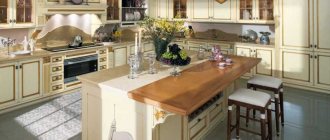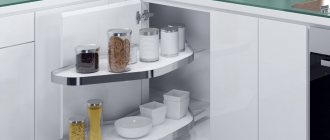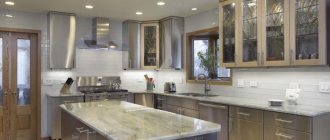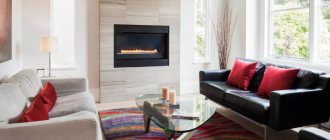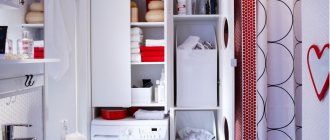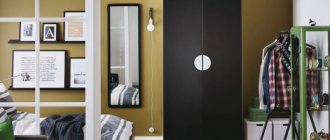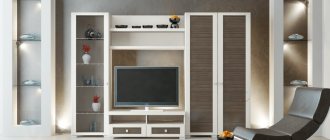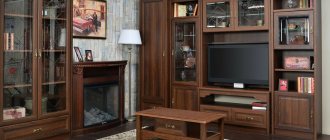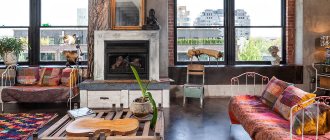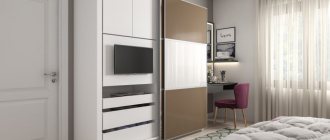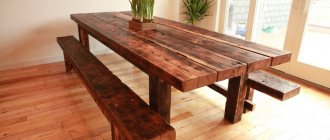Every owner and mistress wants his house or apartment to be a standard of comfort, style and coziness. In addition to this, it is desirable that the furniture does not clutter up the space and is as practical and spacious as possible. How to combine all these qualities in one product? And is it really possible to do this?
In this case, there is only one way out - to make custom built-in furniture for your house or apartment. It has many advantages and features, which we will look at in this article. Some people are familiar with this concept, while others are confused, believing that the old mezzanine above the entrance to the kitchen is built-in furniture. In fact, such products are distinguished by their variety, practicality and ease of use.
What are the styles of furniture in the interior?
Currently, there are about 50 different style trends that can be used in interior design. Among them are the main traditional types, as well as their various interpretations and variations. Needless to say, each designer has his own interpretation of the established style, which always results in something new.
All modern furniture styles, photos of which are widely presented on the Internet, are divided into three large categories:
- ethnic;
- historical;
- modern.
Any direction can be classified as one of these groups. Thus, Japanese style can be included in the ethnic category, while loft is characterized by its modern theme.
Let's take a closer look at furniture styles with photos and descriptions!
Classification of furniture and methods of its manufacture
Depending on the place of use and the purpose that the furniture should serve, it is divided into three main groups - room, office and special, and the latter includes all other furniture and fixtures, for example for shops, cinemas, theaters, clubs, nurseries, etc. P.
Furniture for living quarters, according to its main purpose, is divided into furniture for work, for example chairs, tables, desks; furniture for relaxation and sleep, such as beds, trestle beds, couches, armchairs; furniture for storing household items, such as wardrobes, chests of drawers, cupboards, sideboards, bookcases; complementary furniture, such as tables, flower stands, shelves, hangers.
A collection of mutually complementary furniture intended for a specific room or part of it, together constituting a single whole that gives the room a special character, is called a set, or set.
Depending on the purpose, there are dining rooms, bedrooms, living rooms, office, and kitchen sets. The headsets can be used in multi-room spaces.
Office furniture includes bureaus, desks with three or two drawers, utility tables, typewriter tables, office cabinets, and chairs.
Furniture for stores can be divided into the following groups: cabinets or shelves, sales tables (counters, racks), cash registers, furniture for displaying goods (slides).
Cabinets and shelving make up the equipment of almost every store and can be closed, open or combined.
Cabinets are divided into trade cabinets, used to store a small amount of goods, with access only for the seller, as well as trade and exhibition cabinets, which have a large glass surface for better display of goods.
Tables (stands) are also divided into trade and trade-exhibition.
The store equipment (Fig. 143) consists of furniture of various groups, standing separately or assembled into a single whole. Most often, you can clearly determine whether furniture belongs to one of the above groups.
There is, however, furniture designed specifically for a specific purpose. It represents combinations of individual items of various groups, i.e. combined furniture.
Rice. 143. Furniture for a store: a and b - cabinets, c - table.
4. Club furniture, as public furniture, should be of durable construction. It is made from pine wood with various surface finishes. Shown in Fig. 144 club furniture is already fully prepared for mass production.
Rice. 144. Furniture for the club: 1 - table, 2 - chairs, 3 - standing hanger.
The club furniture set consists of the following items: a square table 1 with a shelf, a chair, a standing hanger, a bookcase, a box for storing sports equipment, a cabinet for a radio and a player, a cabinet, a slide for musical instruments, a podium, and a stand for a notice board.
From the items mentioned above, we will get acquainted with the design of the table and bookcase.
Table 1 for the club has the following dimensions: top cover 85X85 cm, height 75 cm. The square shape makes it possible to arrange tables in a row. For convenience, there is a shelf under the table cover for folders and bags. The drawers in it have been eliminated for the free position of the legs of those sitting. The use of cross-shaped jumpers and stops at their upper end instead of drawers for table legs, as well as the connection of crosses with legs (if wedges are used) ensure sufficient stability of the structure.
Rice. 145. Bookcase: 1 - plank, 2 - crown, 3 - doors, 4 - shelf, 5 - back wall, 6 - lower part doors, 7 - base, 8 - side wall.
Since the top cover is connected to the leg stops using screws and non-glued dowels, the table can be disassembled, which is very good for transportation.
The bookcase for the club (Fig. 145) consists of an upper part intended for books, and a lower part for periodicals.
The upper part of the cabinet is closed by folding doors 3, at the ends of which there are pins that move in the guide grooves of the upper panel 2, and the lids of the lower part.
The doors are made of laminated softwood plywood; each half of the door consists of two parts connected by a cloth glued at the fold. At the top, the parts are connected by means of a groove to a pine plank 1, at the end of which studs are placed. One pair of pins constitutes the axis of rotation of the wing, the second moves along the guide groove; This system makes it possible to open doors without taking up space in the front and sides of the cabinet. Therefore, the cabinets can be placed in a row.
The lower part of the cabinet, intended for newspapers, has double-leaf doors of a paneled design.
5. Furniture for theater and cinema consists of chairs and hard or soft armchairs produced in bent furniture factories (Fig. 146).
Rice. 146. Chairs for theater and cinema: a - hard chair, b - soft chair.
Dependence of furniture design on its purpose.
As already mentioned, furniture for work and rest must be adapted to the shapes and sizes of the human body in such a way that it is most comfortable. For example, children's furniture should be adapted in size and shape to children. Table height for 4-6 year old children is 25-30 cm; for 6-8 year olds - 30-35 cm, for 8-14 year olds - 35-60 cm.
The height of chairs and armchairs from the floor to the top of the seat should be within 44-46 cm. The most comfortable backrest is 85-87 cm high; the arms of the chair are placed at a height of 66-67 cm. The height of bureaus and tables ranges from 77-80 cm.
Cabinets for storing clothes and linen should protect them from dust accumulation. The dimensions of the closets should be such that the stored clothes do not wrinkle. Therefore, the total height of the cabinet should be 180 cm, and the depth should be at least 55 cm.
- Back
- Forward
Manufacturers themselves classify furniture according to the following basic characteristics:
1) Depending on the materials used
According to the material of manufacture - chipboard (laminated chipboard), MDF, solid wood (wood panel) and various combined options.
2) By age orientation
Depending on the age orientation (furniture for children, teenagers, adults) - products whose shape, designs and sizes are designed for certain height and age characteristics of people.
3) By the nature of production
According to the nature of production, furniture is divided into:
- experimental production - this includes furniture manufactured in piece quantities (usually up to 10 copies) for exhibitions and artistic and design assessment (determining the manufacturability of production, for testing, analyzing consumer preferences, etc.);
- individual production - furniture made to order according to certain parameters;
- mass production – irregular production of template furniture in large quantities. Usually, after several releases, the series changes, but the saved equipment (templates, forms, calibers) allows production to be resumed if necessary;
- mass production – production designed for the continuous production of large batches of furniture according to a specific template over a long period of time.
4) According to production method
According to the production method, wooden furniture can be:
A) Bent - consists partially or completely of bent elements, which are assembled using metal fasteners (screws, bolts with nuts, wood grouse).
B) Wicker - made by various weaving of flexible wood (mainly from willow branches, bamboo, rattan).
C) Carpentry - furniture assembled from straight elements and parts of complex shapes, made on cutting machines using turning, milling, sawing. The connecting link is various fasteners and glue.
5) Design features
According to design and technological features:
A) collapsible - furniture, the design of which allows for repeated installation and disassembly;
B) non-separable – products with permanent connections;
C) sectional - structures consisting of two or more sections that can be combined, installed next to or on top of each other. This also includes furniture sections that are manufactured as a separate finished product, but can be used in whole or in part as part of a group combined into a block;
D) built-in furniture, the design feature of which is the absence of walls, sides, roof, bottom or all of the above (only sectional partitions, shelves and the front side are required);
E) transformable - furniture items made according to the “two in one” principle - sofa bed, chair bed, table, cabinet, etc.
6) Wooden furniture by destination
By destination - for indoor or outdoor use;
7) Completeness
By completeness:
- single piece of furniture;
- a group of individual products interconnected according to certain constructive, architectural and artistic principles, assembled into a set or set.
 Exploitation
Exploitation
According to operational purpose:
A) for home (household) - includes furniture for a common room, bedroom, bath, dining room, kitchen, office, hallway. This also includes furniture for a summer house and furnishings for a children's (teenage) room;
B) for public enterprises - educational organizations, trade, laboratory, industrial premises, catering, consumer services (including shops, pharmacies, hospitals, administrative premises, medical institutions, hotels, children's schools and preschool institutions, libraries, etc.) d.);
C) for transport - furniture intended for equipping various vehicles. A complete list of furniture broken down into categories and classified according to certain criteria can be found in GOST 20400-80 “Furniture production products. Terms and Definitions".
Classification and assortment of household furniture
The range of furniture can be grouped according to many criteria: material, purpose, types of premises, age, design, function, rigidity, completeness, finishing, types, subtypes and models of products.
By material
furniture is divided into wooden, metal, plastic and combined.
By purpose
furniture can be household, office, school, etc. The textbook discusses household furniture.
Type
premises there are household furniture, for living rooms (bedroom, living room, office), kitchen furniture, for the front room, bathroom, country house, etc.
By age
There is furniture for adults and children.
By nature of production
furniture is divided into experimental, serial and mass-produced;
According to production method
– for carpentry, bent, bent-glued, wicker and pressed, molded, stamped and cast (from metal and plastics).
According to constructive and technological characteristics
furniture is divided into built-in, mobile, transformable, universally prefabricated, timber, cabinet, collapsible, non-dismountable, folding, sectional, shelving, combined, etc.
Built-in furniture is stationary; it is one piece with a wall or partition of the room. This includes partition cabinets.
Mobile furniture can be collapsible or non-collapsible. Collapsible furniture is more convenient for moving inside the apartment, as well as for packaging and transportation.
Bar furniture consists of individual bars (stools).
Cabinet furniture consisting of panels can be framed or panel furniture. Furniture with a frame structure is assembled from individual panels, which are ready-made elements. It is heavier and more material-intensive compared to frame ones, and has flat surfaces, which makes it easier to care for. Frame furniture is more hygienic.
Collapsible (prefabricated) furniture, in turn, can be sectional (composite), consisting of individual sections that can be used in various combinations; rack - sections and shelves are mounted on vertical supports (racks); prefabricated - from planar elements (plates, shelves) connected by bolts, angles and other fastening devices. Non-dismountable furniture can be ordinary, folding and transformable. The design of transformable furniture allows you to easily change the position of the main parts (assemblies) and thereby adapt the product to perform various functions. For example, an armchair-bed, a sofa bed, a sideboard, a secretary cabinet, etc. - allows you to economically use the living space, especially during the daytime; The occupancy rate of residential space is approximately 30 – 35%.
By function performed
There are monofunctional and multifunctional furniture. Monofunctional is…furniture for sitting, sleeping, relaxing, working, cooking and eating, storing, installing and placing various items.
Multifunctional furniture includes transformable, universal and combined furniture. Universal is usually called sectional and rack furniture, individual sections or racks of which are used for various purposes (storing books, linen, dishes, installing television and radio equipment, as a secretary, etc.). Combined cabinets include cabinets with two or three compartments, each of which is adapted for storing various items (dishes and cutlery, linen, etc.).
By hardness
(the amount of deformation and compliance of the soft element) furniture is divided into hard (without flooring or with flooring up to 10 mm) and soft (with flooring up to 70 mm and an elastic part of a spring or other type). Upholstered furniture, depending on the amount of deformation of the soft element under a load of 70 kgf/mm, comes in different softness categories (I, II, III and IV).
According to completeness
Furniture is divided into piece furniture and complete furniture - sets (bedrooms, dining rooms, living rooms, office rooms, kitchens) and sets (for one-, two- and three-room apartments), consisting of products of a single artistic and design solution.
Finishing
furniture is varied. Finishes are classified according to the method of application, type of film former, degree of transparency and gloss, and categories. The main methods of finishing furniture are: applying paint and varnish coatings - varnishing (including airbrush), polishing, depolishing (smoothing and increasing the shine of the varnished surface with polishing compounds), paneling - applying transparent polymer films, enameling; pressing of layered polymer materials - films, decorative plywood, decorative laminates, textured paper; obtaining a typesetting or relief pattern; inlay (cutting and gluing of pieces of wood, metal and other materials), carving, etc.; decalcomania and printing. To give the wood the appearance of valuable species, imitation finishes are used.
Depending on the type of film-forming agent, finishing can be polyester (PE), nitrocellulose (NC), polyvinyl chloride (PVC), urea aldehyde (MC), etc.
Based on the degree of transparency, a distinction is made between transparent and opaque finishes. Clear finishes (varnishing, polishing, de-polishing and paneling) are applied to beautifully grained wood products. Opaque finishes are used primarily for products made from softwood and inexpensive hardwood.
According to the degree of gloss, finishes are distinguished: high-gloss (HG), glossy (G), semi-gloss (PG), semi-matte (PM), matte (M). When finishing the surface of furniture made of solid wood or natural veneer with varnishes, the pores of the wood can be open or closed.
The finishing category (I, II, III and IV) is determined depending on the type of film former, thickness and appearance of the coating: gloss and presence of defects. Category I includes coatings with a high degree of gloss, without defects visible to the naked eye; Category II - based on PE, NC, MP paint and varnish coatings and film coatings made of thermosetting resins, of varying gloss, with visible defects that do not affect the operational properties of the furniture; to III - with varnish and film coatings based on thermosetting resins with visible and noticeable finishing defects to the touch. Category IV includes the finishing of the internal walls of the product.
View
furniture characterizes products with one functional purpose, for example, a cabinet, a table.
Subspecies
furniture is allocated to designate products for a narrower purpose. For example, a linen closet, a dining table.
Model
furniture is determined by the features of the artistic design solution and is indicated by indices.
Wooden furniture is furniture in which the design is dominated by parts made of wood and (or) wood materials. Wooden furniture forms the basis of household furniture.
Plastic furniture is furniture in which the design is dominated by parts made of plastic. The range of plastic furniture includes country furniture and bathroom furniture. The main polymer materials of such furniture are impact-resistant polystyrene, polymethylacrylate (plexiglass), polyvinyl chloride, fiberglass, etc. The range of plastic furniture includes tables, chairs, stools, chair frames, drawers, hanging shelves, sink cabinets, etc.
Metal furniture is furniture in which the design is dominated by metal parts. In addition to metals and their alloys, wood, plastic, and fabrics are also used. By combining materials, metal furniture of sufficiently high strength is produced. Furniture made from metals includes a varied assortment of beds, which can be collapsible, folding, for adults and children. Furniture with metal frames includes chairs, armchairs, sofas, tables for audio and video equipment, and coffee tables.
Assortment of wooden furniture. The range of wooden furniture is much more diverse than furniture made of metal and plastic. According to the production method, it is divided into carpentry, bent and wicker.
Carpentry furniture. Carpentry is furniture where most of the parts are straight; the back legs and backs of chairs, as well as some other parts of carpentry furniture can be curved (bent).
In addition to the general characteristics discussed above, the range of carpentry furniture is divided according to the nature of the preparation of parts, the design of the main components and other characteristics.
By nature of the preparation of parts
A distinction is made between carpentry furniture made from solid wood and lined (veneered) with sliced veneer of hardwood - beech, oak, ash, maple, silver birch, and larch.
Furniture made from solid wood is grouped by species - birch, beech, oak, ash, etc.
According to the design of the main components
A distinction is made between block carpentry furniture - units consisting of individual bars (stools, chairs) and cabinet furniture. Cabinet furniture can be panel furniture - all planes are made of panels (wood, fiberboard or particleboard), frame - planes are made of frame-tips filled with plywood panels, and frame-panel.
The main types and varieties of carpentry furniture, depending on the functions performed:
- for sitting -
stools (kitchen and piano), chairs with lattice or plywood backs, armchairs, banquettes (stool-type products with a semi-soft or soft seat, sometimes with armrests), poufs (round or square products on low legs, with a soft or semi-soft seat);
- for lying down
— sofas, armchairs, couches, beds, sofa beds, chair beds, sofas, ottomans;
- for work, cooking and eating
— desks, computer tables, kitchen tables, dining tables, serving tables, etc.;
- for storing clothes, books, dishes and other items
— wardrobes for clothes, linen, books, shelves, sideboards, cupboards, secretaries, chests of drawers, cabinets, etc.;
— furniture for cultural and household purposes
— dressing tables, coffee tables, chess tables, dressing tables, trellises, TV stands, radio equipment;
- for other needs
– stand for newspapers, etc.
What are materials for furniture cladding and why are they needed?
Modern facing materials are a popular type of finishing. Their main function is to decorate or decorate furniture, giving it a presentable appearance and exclusivity. It is with the help of facing materials that today the furniture market offers a huge variety of sets and individual items of various colors and reliefs.
The cladding material is applied in a thin layer to the surface of the furniture by gluing or pressing. This process should not be confused with finishing work - unlike grouting, painting and impregnation, the facing material can be picked up, bent, rolled up. It, unlike finishing liquids and solutions, has physical properties.
Modern furniture manufacturers use cladding material regularly. It is used for finishing:
- cabinets;
- kitchen sets;
- bathroom furniture;
- interior and entrance doors.
In addition, facing materials are used for external finishing of walls and ceilings.
The enormous demand and popularity of facing materials is explained by their advantages.
Furniture decoration
Using colored mosaics, decorative glass, film or veneer, you can create a wide variety of furniture decoration options.
Thanks to this feature, any nondescript surface can be given an incredibly stylish and attractive look.
The best kitchen layouts - planning principles and kitchen decoration options (video + 80 photos)
Saving
Everyone knows that furniture made from natural wood is very expensive, and not everyone can afford it. Thanks to the facing material in the form of natural veneer, cabinets and chests of drawers made from the more affordable MDF material look no less presentable than their counterparts made of natural wood, while at the same time having a price that is 2 times lower.
Big choice
Today, the buyer can choose the type of facing material, the type and properties of which will completely suit him. Affordable cost and variety of choice often win over natural furniture, the outer coating of which is only clear varnish.
A large-scale breakthrough with the advent of facing materials occurred in the production of kitchen sets: glossy and matte facades of various colors that modern housewives like so much saw the light of day.
Dining tables
These are representatives of another furniture group. The kitchen table is the decoration of the kitchen. In addition to the fact that the dining table must be characterized by external aesthetics, it must also be practical, functional, reliable, wear-resistant, and consistent with the design of the room.
Today, tables are represented by a huge variety, made of various materials, made in various styles, in addition, modern models differ in design and folding method. Tables are available in a variety of configurations and can be large, small, round, square, rectangular. Dining tables can be folded out like a “butterfly”, “book”, or be equipped with an additional one or two or more tabs inserted into the middle of the table structure. In addition, tables may differ in the material from which they are made. Tables are made of wood, glass, metal, plastic.
15
; Topic: Furniture; Sector: Theoretical articles
Buy the right bed and mattress without embarrassment or shame
Have you noticed that every night has become torture for you? You don't get enough sleep because you're always...
Connecting the power supply to kitchen units
When renovating apartments, a problem always arises with the kitchen unit, or rather with the built-in power...
Types of furniture and main groups
There are several groups into which all pieces of furniture can be combined: cabinet furniture...
You might be interested
- This may be the best option for buying linoleum flooring, because it is durable, has beautiful and varied color options, is easy to clean, clean and maintains high-quality sanitary condition
- Discover how, thanks to modern materials, the technology of floor screed has become much easier, it is especially convenient to perform dry floor screed
- See how you can use artificial stone in the interior and how to produce it on site
By design
Depending on the design features, furniture is produced:
- Modular - with several independent sections (modules), with the help of which any structure can be assembled.
- Built-in – integrated into the walls (niches). Such furniture saves space, but when its location changes, the integrity of the objects or the unity of design is disrupted.
- Transformable - changing size and purpose when rearranging components. Furniture pieces make optimal use of space in a small apartment.
Lesson. 100-101. Classification of commercial furniture and requirements for it
Commercial furniture is usually classified according to the following criteria:
by functional purpose - for storage (racks, pallets, stock racks), preparation of goods for sale (tables for packaging, packing, quality assessment, cutting and rejecting), their display, display and sale (slides, display cases, counters), transportation, storage and sales (containers), settlements with customers (cash booths), additional services (fitting booths, mirrors, packaging tables);
at the place of use - for sales floors, premises for receiving, short-term storage, preparation of goods for sale;
by installation method - wall-mounted, island-mounted, showcase-mounted, wall-mounted and built-in. The most common are wall-mounted, island and display-type commercial furniture, which is divided into mobile and stationary.
Depending on the design, commercial furniture is divided into:
► according to the principle of the device - shelf, frame, tubular;
► in terms of completeness - parts, elements, fixtures, compositions of slides (these are groups of different purpose, but unified slides with the same architectural and artistic design);
• according to the assembly method - non-dismountable, collapsible and folding. Non-dismountable furniture is assembled using welding, screws and screws, glue; collapsible with hooks, staples, bolts, screws; folding - using various types of hinge joints. Prefabricated equipment consists of individual standardized parts, from which finished individual products or sections interlocked in a line can be assembled;
• according to the material of manufacture - plastic, glass and mirrors, metal, wood, combined, using metal, wood, chipboard, glass and plastics in various combinations.
In relation to the forms and methods of selling goods, commercial furniture is classified:
• by product profile - specialized retail furniture (for certain product groups) and universal (for various product groups);
• for the organization of trade services - for the sale of goods with individual customer service (counters, sections, closed cabinets with access only from the seller); for the sale of goods using the self-service method (open display cases, counters, racks, hangers accessible to the buyer); for the sale of large non-food products according to samples with home delivery (podiums, racks); for the sale of food products based on advance orders from customers (demonstration display cases).
Depending on the nature of the trade and technological process of selling goods, commercial furniture is classified:
• according to the content of the trade and technological process - technological, exhibition, accessory furniture;
• in terms of the progressiveness of the technology for the delivery and sale of goods - using container equipment (containers, pallets, hanging containers).
Depending on the needs of the customer, commercial furniture is divided into standard and exclusive, manufactured to individual orders.
Depending on the nature of production, commercial furniture is classified:
• by novelty - experimental, traditional;
• by serial production - small-scale, serial and mass production (large-scale).
Operational and technical requirements.
When designing commercial furniture, the leading principles are standardization and versatility. Trade furniture should be developed taking into account the latest achievements in the organization of trade and meet modern requirements of technical aesthetics. Its parts must be interchangeable, have sufficient strength (rigidity and stability), ease of assembly, and manufacturability. Retail furniture should ensure optimal use of the store's sales area, ease of replenishment of goods, demonstrative visibility and free access to goods for customers.
The requirement for prompt replenishment of goods is met by retail furniture equipped with removable baskets, container trolleys, trays that can be loaded with goods in utility rooms or delivered to them directly from the supplier without manually transferring them from containers to slides and other equipment in the store.
When designing retail furniture, they strive not only to maximize its exhibition area, but also equip some of its types with built-in fluorescent lighting, inclined brackets, mirrors and other devices in order to ensure a wide display of goods and create maximum convenience and comfort for customers when selecting goods. Ergonomic requirements. The design of commercial furniture is carried out taking into account the average anthropometric data of a person, which largely determines the size of the equipment. The main parameters of retail furniture (length, width, height, distance between shelves, baskets, cassettes) must correspond to the average anthropometric data of a person, minimize fatigue during the work of service personnel, ensure sufficient visibility and free access to goods.
Aesthetic requirements.
It is necessary that the shape, proportions and color of retail furniture correspond to its functional purpose and the architectural and artistic design of the interior of the trading floor. Retail furniture must meet the following aesthetic requirements:
• finishing must be linked to the overall solution for the arrangement and technical equipment of the sales area,
• the color of the furniture and its individual elements should be in harmony with the interior of the store and emphasize the features of the goods displayed;
• light sources must be positioned so as to highlight the product and draw the attention of buyers to it;
• when designing commercial furniture, one should take into account the possibility of using modern technological and finishing materials;
• when installing retail furniture in a line, there should be no visual impression of sagging shelves and disharmony in the design solution.
Sanitary and hygienic requirements.
The structure of commercial furniture, as well as the materials used for its manufacture, should not make it difficult to clean during operation and cleaning of commercial premises. In this regard, commercial furniture must have a high-quality finish with a smooth surface without unnecessary gaps, protrusions and recesses.
Working surfaces of retail furniture that come into contact with products must be made of materials approved for use in the trade of food products.
Contamination from the surfaces of commercial furniture is removed only by dry cleaning. Surfaces covered with plastic are wiped with a swab soaked in a 5% permanganate solution. It is not allowed to wash commercial furniture with a heavily dampened, unwrung rag. Moisture, penetrating into the cracks between parts and connecting fittings, leads to swelling of wooden parts (especially chipboard) and corrosion of metal parts.
Assignments: using lecture material, Internet resources, presentation:
Answer security questions
1) Why do commercial enterprises need furniture?
2) What types of furniture are there depending on the installation method?
3) What principles are used when designing commercial furniture?
4) What are the aesthetic requirements for commercial furniture?
5) How do you remove dirt from the surfaces of commercial furniture?
2. Fill out the diagram:
| Classification of commercial furniture |
| Intended for display and sale, display, storage |
| By place of use |
D/z Make a list of commercial furniture (to choose from) for stores like:
Furniture
Dishes
Construction Products
Cloth
Shoes
Jewelry
Peculiarities
Modern home furniture has a number of differences from models of the last or the century before:
- Appearance;
- Design;
- Material;
- Functionality;
- Number of moving elements;
- Production technology;
- Build quality.
If you look at the development of furniture, you can see a desire for minimalism. Current products are compact in size, light in weight, have a simple design and still fully perform their functions. Using chairs as an example, one can clearly see trends towards increased comfort and simplified design.
There is an interesting version of the change in priorities in the development of furniture. Previously, landowners, slave owners, kings. They didn’t work themselves and mostly invested money in furniture and home improvement to show off to others. Therefore, priority was given more to beauty, size and appearance than functionality and mobility. When people's rights were equalized, the need for excessive pomp disappeared and ergonomics and practicality came to the fore.
Upholstered furniture - a zone of home comfort
In the usual sense, upholstered furniture is a set of sofa and armchairs. In fact, the types of upholstered furniture are more varied and interesting. This includes a sofa, pouf, ottoman, couch, sofas with corner inserts in the form of shelves and small tabletops.
The main purpose of upholstered furniture is comfortable and cozy rest. Therefore, most often soft areas are located in the living room, and sometimes in the bedroom.
All upholstered furniture can be divided into main types.
By type of transformation:
- Fixed.
- Folding - books, Euro-books, accordions, dolphins and others.
By type of folding mechanism:
- Roll-out.
- Retractable.
- Transformer.
By number of beds:
- Single.
- Double.
- Three bedroom.
According to the material:
- Fabric.
- Leather.
For assembly:
- Modular.
- One piece.
By mattress type:
- Spring.
- Springless.
It also differs in its frames and materials for padding and upholstery.
According to manufacturing technology
- Switchboard . It is made from wood-replacement panels and panels (plank, hollow and glued). The cost of the finished product is low due to inexpensive carpentry materials.
- Frame . The body is assembled from high-quality expensive frames and special inserts (panels), for which cheaper material is used. This type of furniture is the most common.
- From the array . Body made of solid wood (oak, hornbeam, walnut, pine, birch). Chipboard is used as standard for internal parts. It is considered an expensive piece of joinery.
Varieties
There are 5 ways to classify furniture products. This is done according to the following criteria:
- Purpose;
- Functionality;
- Material;
- Design;
- Exploitation.
Let's consider the design varieties separately and find the advantages and disadvantages of each of the available solutions.
Built-in furniture
The latest design trends involve economical use of free space. Distinctive characteristics of the built-in design:
- Suitable for installation in niches;
- There is no back/side surfaces, instead there are walls;
- Lots of free space inside;
- Economical use of space;
- Tight fit to the wall;
- Effective use of the vertical plane;
- Reliability.
It has become fashionable to install sliding wardrobes. Sliding doors are placed between the two walls, like in compartment cars, and the interior space is used for storing things. The doors are covered with a mirror film, which visually expands the room. A convenient solution for small rooms or rooms with high ceilings.
Built-in furniture is often placed along the entire wall to maximize free space and use it for storage. The wall itself is part of the furniture. A few photos as an example.
Transformer and retractable elements are often built into modern furniture. When you raise the mobile element, you get a full-fledged table and workplace; when you lower it, you get a bed. Convenient and ergonomic.
Advantages:
- Space saving;
- Ergonomic design;
- Collapsible design;
- Sectional division of space;
- Product strength;
- Effective use of vertical space.
Flaws:
- The need to design the structure individually for the apartment;
- Difficulty moving.
Modular options
The most common are modular products. The complete set consists of many different modules: cabinets, shelves, drawers. This solution is popular due to its ease of movement. If necessary, modular furniture can be easily rearranged or moved to another room. Therefore, such options are often used in offices.
Pros:
- Fits freely into the interior of different rooms;
- You can buy sets separately;
- Easy to move.
The disadvantages include the risk of errors when joining modules.
Transformer cases
High-tech furniture implies increased functionality and ergonomic use of space. A person uses a bed mainly only for sleeping; the rest of the time it simply takes up free space. Therefore, the designers came up with an interesting solution - to use both surfaces of the product. On one side there is one piece of furniture (table, wardrobe, sofa), and on the other side there is a mattress or other soft surface.
Advantages:
- Convenient for saving space;
- Multifunctionality;
- Non-standard look.
Flaws:
- Must be disassembled before use;
- Many moving elements (high risk of breakage);
- Difficulty in self-repair of the structure;
- Over time, fasteners need to be repaired.
Cushioned furniture
This category includes beds, sofas, armchairs, chairs, poufs and other soft products. There is huge potential for imagination here. Non-standard shapes, colors, upholstery, designs. In this assortment, every buyer will be able to find a product to his liking.
In Rus', soft beds appeared by the 17th century. Before this, people of different classes spent the night on stoves, shelves under the ceiling or on benches.
Upholstered furniture can be divided into:
- Sofas (sofas, chaise longue, couch, ottoman);
- Beds;
- Poufs;
- Armchairs.
Sofas and armchairs often have a folding design. If necessary, the lower part can be pulled out and the living room sofa turns into a full double bed. A convenient solution, especially if someone is staying overnight.
They differ from each other mainly due to their design. Recently, poufs have been gaining popularity - comfortable and beautiful analogues of chairs. They bring comfort to the apartment and dilute the same type of interior with bright colors.
In upholstered furniture, close attention must be paid to the choice of upholstery and filling materials. They determine the appearance and service life of the product. For home and office spaces, it is better to choose dense fabrics such as tapestry or courtesan; they are easy to clean and are not subject to physical damage.
Antique furniture and styling for it
Such products reproduce the atmosphere of a certain era: from ancient times to recent centuries. If we consider historical styles, they are always natural materials, regular geometric shapes and smooth soft tones of upholstery. The antique style in furniture is also called classic or historical. This furniture has elegant lines and timeless beauty. Tables, armchairs, sofas and chairs are respectable, comfortable and give a unique feeling of peace and comfort. What you should avoid when styling when choosing things is museum-likeness and stiffness. When choosing a sofa or bed, it is important to feel the desire to sit or lie down, and not to arrange objects and admire them, being afraid to approach.
Antique objects amaze with their variety of designs and speak of their owner’s love for beauty, emphasizing status and individuality. Furnished in antique style, the house is a sign of luxury and wealth.
The furniture of the past was richly decorated and made from expensive types of ebony and mahogany, usually by hand, using special technologies passed on from generation to generation. The main characteristics of antique furnishings are listed below:
- furniture made of wood, decorated with carvings in the form of elaborate designs;
- upholstery with leather, natural fabrics, tapestries;
- forging individual elements with iron strips.
The definition of antique style occurs according to a number of characteristics. Things in the old days were always made massive:
- wooden chairs - with high backs or wide seats, on which ladies placed their full skirts;
- tables are always of the correct shape, quadrangular, round, trapezoidal;
- antique style cabinets and chests of drawers - large, roomy, chest-like, placed vertically;
- beds have a canopy and a richly decorated headboard.
Antiques can be preserved for centuries; if necessary, furniture is restored in workshops: blackened wood is bleached with a special bleaching paste, the clarity of the carvings and the shine of the metal plates are restored.
Not everyone can afford to buy real antiques. Modern manufacturers, realizing this, provide the opportunity to decorate the interior with things that copy historical trends, producing antique furniture on modern equipment according to samples of the past. Certain techniques are used in production: artificial aging, bleaching, decoupage. Varieties of antique styles:
- antique;
- Gothic;
- Rococo and Baroque;
- Empire;
- modern;
- Provence
This also includes Art Deco and Art Nouveau, popular at the beginning of the 20th century, and Biedermeier. Nowadays, luxurious pseudo-antique furniture is produced by Romanian and Italian companies: they are skillfully whitewashed, creating the effect of patina and gold leaf.
Antique styles in furniture and its varieties
Antique style furniture
Decorating a house in antique style is inspired by the motifs of Ancient Rome and Ancient Greece: a lot of light, space, stucco columns and moldings, tiled marble floors. Stylistic ornaments in the form of spirals, meanders, leaves, and architectural elements frame the edges of bedspreads and tablecloths. Antique-style furniture is often unupholstered, simple in shape, smooth and wooden with inlay in the form of a mosaic of precious stones or other types of wood. In the center of the room there is a one-legged or three-legged table with a marble top on stylized animal paws. Tables, benches, low chairs on curved legs in the antique style are quite low, often trapezoidal in shape. There were no wardrobes in ancient times: chests were used. Therefore, additional accessories are required - cabinets, chests, baskets, couches, low benches. The decor is complemented by amphorae, griffin figurines, and statues.
The style is characterized by light, monochromatic colors of furniture and walls.
Gothic furniture style
Gothic furniture is made in dark shades of wood, decorated with many carved elements. Made from natural wood: oak, walnut, spruce, pine and cedar. Brief description of Gothic: precise geometry of shapes, clear embossing and extraordinary design. The fashion trend originated in the Middle Ages in the 12th century. It is not surprising that the Gothic style resembles the atmosphere of medieval castles and church vaults: high ceilings, plenty of light, candlesticks and dark tones of the furnishings. During this period, wardrobes and upholstery on chairs, armchairs and sofas appear.
Renaissance furniture
The famous Renaissance interior is luxurious and is often used to decorate country houses, turning them into a luxurious palace. The main items - a chest of drawers, a secretary, a sideboard, a chest upholstered in brocade or leather, chairs - have clear shapes and are decorated with architectural gilded elements. Mandatory additions include metal openwork chairs, wrought iron furniture, and ivory decorative inserts.
The Renaissance interior is decorated with massive candelabra, paintings on the walls and ceilings with gilded stucco. A characteristic piece of furniture is the cassone chest, decorated with painting and gilding with inserts of different types of wood.
Baroque and Rococo
Baroque is also called palace splendor due to the pomp and rich decoration of the interior. The main emphasis is on luxurious gilded furniture in pastel shades with rounded contours. Everywhere: on armchairs and chairs with carved backs, huge wardrobes and four-poster beds there are sophisticated curved patterns.
Baroque furniture is made from bent solid walnut and oak, decorated with carvings, gilding and upholstery in expensive fabric.
Baroque in the era of Louis XV gave way to the Rococo style, which was less focused on symmetry and allowed silver in addition to gilding. Rococo, as a variant of Baroque, has the same arched lines and luxury. Unlike Baroque, Rococo is more airy and gentle.
Basic shades of Rococo: white, mixed with blue, pink, green
Empire and classic
Empire - imperial style, dates back to the Napoleonic era, reminiscent of antique. The main material of manufacture is mahogany. There are gold-plated ornaments and decorative bronze overlays throughout. Color scheme: white with gold plated. Furniture items often feature the letter N, Napoleon's initials.
Classics are defined by the following characteristics: strict lines, symmetry and proportions. The main decoration is the texture of the wood, partially decorated with carvings, gilding, and decorative elements made of bronze. There are no unnecessary patterns here, only respectability, harmony and calm shades. Classic furniture has right angles, monumentality, graceful legs and expensive upholstery with floral patterns.
Biedermeier
The design movement arose in 19th century Germany as an option to adapt pompous palace styles to the modest needs of the middle class. Biedermeier retained the luxury motifs of Empire, Baroque, and classics: light wooden furniture with smooth outlines on curved legs upholstered in floral patterns, impressive round tables, corner cabinets and dressing table. Everywhere there is naturalness, proportionality and a certain sentimentality. The walls are decorated with wooden panels and covered with wallpaper with fine patterns in warm shades.
Style elements: sideboards and buffets with dishes, grandfather clocks, embroidery and other cute little things
Art Nouveau
Objects in the Art Nouveau style have streamlined semicircular shapes and are inextricably integrated into the ornamental system of floral motifs. Art Nouveau furnishings are associated with the smooth movement of curved lines of plants and soft aesthetics: there are no right angles, muted light and natural colors are everywhere. Pretentious lines are present in everything: mahogany cabinets and doors, fireplace mantels, backs of chairs, sofas, beds - all arched. The upholstery of upholstered furniture is decorated with floral patterns. This is a decorative trend based on the wavy lines of plants and flowers, turning metal structures into bizarre thickets. Art Nouveau colors are pastel, sometimes white and gold.
The interior is complemented by white moldings, marble, dull silver, stained glass and semi-precious stones
Art Deco
Art Deco furnishings are based on a combination of black and white colors, grey, beige, brown with the use of metallic and silver shades. Art Deco furniture pieces combine dark wood with metallic elements, and sharp geometric shapes are present throughout: trapezoids, stripes, zigzags and beams. Preferred upholstery is leather and natural materials.
Art Deco is based on lightness, elegance and allows you to create a luxuriously elegant interior thanks to bright walls, glossy surfaces and an abundance of lamps
Types of cabinet furniture
- Built-in - in this case, a cabinet or rack is mounted in a wall niche or attached to one or two walls. Such furniture is installed more firmly, saves materials (instead of one or two walls there is an apartment wall), and also saves space, leaving no gaps between the cabinet and the wall. However, built-ins are more often custom-made and can have a higher cost.
Growing grapes in the country: planting, care, reproduction, pest control (photos, videos)
Not only a closet can be built-in, but also, for example, a chest of drawers
- Free-standing - just choose the furniture set that is most suitable in size and color and assemble it on site, like a construction set. If necessary, a closet or chest of drawers can always be moved; underneath there is a regular laminate flooring, and behind it there is the same wallpaper as in the entire room.
Non-built-in furniture in a niche creates unsightly gaps
What applies to cabinet furniture?
- Desks (computer, but not dining)
- Dressers and cabinets (except solid)
- Beds (except solid)
- Wardrobes and sliding wardrobes (except solid)
- Hallways (wardrobes, chests of drawers, cabinets, hangers)
- Living rooms (wardrobes, bedside tables, chests of drawers, mirrors, drawers and shelves)
- Furniture for the bedroom (beds, nightstands, chests of drawers, wardrobes, mirrors)
- Furniture for a children's room (beds, including bunk beds, tables, cabinets, cabinets, chests of drawers, wall shelves and racks)
- Kitchens (floor sections, wall cabinets and shelves, bar counters and islands)
- Office furniture (cabinets, cabinets, tables)
- Furniture for shops and dentistry
- Shop and pharmacy display cases
What does not apply to cabinet furniture?
- Upholstered furniture (sofas, armchairs and couches, as well as mattresses)
- Tables (dining, coffee and glass, but not computer)
- Chairs (both dining and office)
- Kitchen corners
- Chests of drawers and cabinets made of solid wood
- Solid wood beds
- Solid wood cabinets
- Solid wood furniture, including antique furniture
Kitchen corners can be framed, but solid wood is much more beautiful and durable
Furniture classification
Furniture is classified according to the following main characteristics: operational, functional, structural and technological, by materials by production method as well as by .
Classification of furniture according to operational purpose
Household furniture is products intended for furnishing various rooms, apartments, cottages or outdoor use. There are the following types of household furniture for:
- common room (for rooms with combined functions, for example kitchen-dining room, bedroom-office);
- bedroom;
- dining room;
- living room;
- office;
- children's (products whose sizes, shapes and designs correspond to the age characteristics and growth characteristics of children);
- kitchens;
- hallways;
- bathrooms;
- dacha
Furniture for public premises is products intended for furnishing the premises of enterprises and institutions, taking into account the nature of their activities and the specifics of functional processes. The following types of such furniture are distinguished:
- medical (for hospitals, clinics and other medical institutions);
- laboratory (for laboratories, including educational and medical);
- for preschool institutions (kindergartens, nurseries);
- for educational institutions (schools, colleges, technical colleges and universities);
- for trade and catering establishments (canteens, restaurants, cafes, snack bars, etc.);
- for consumer services, hotels and health resorts, theatrical and entertainment institutions, libraries and reading rooms, sports facilities, administrative premises, waiting rooms of transport institutions, communications enterprises.
Furniture for transport is products designed to equip various means of transport.
Classification of furniture by functional purpose
Furniture for storage (cabinet) , the main purpose of which is the storage and placement of various items. The following products of this furniture are distinguished:
- cabinets for clothes, linen, dishes, books;
- kitchen cabinet is a product designed for storing kitchen and household items. It can be part of the working front of the kitchen or be a separate product;
- kitchen cabinet-table - a product intended for cooking and serving, with containers for storing kitchen utensils and food products;
- cabinet under the sink - designed for installing a sink;
- cabinet with display case (showcase) - a glazed piece of furniture designed for storing and displaying various items;
- cabinet-partition - a product designed to divide a room into separate zones;
- wall cabinet;
- multi-purpose cabinet - a product with compartments for various functional purposes;
- chest of drawers - a product with drawers for storing linen;
- toilet cabinet - a product with a mirror and containers for storing toiletries;
- low-height cabinet cabinet for various purposes;
- secretary - a product with a folding door or a retractable board intended for performing written work;
- sideboard cabinet - a product for storing dishes and table linen, the upper plane of which is used for serving work;
- chest - a piece of cabinet furniture with a folding or removable top lid, designed for storing various things;
- shelf - a product without a front wall, with or without a back wall, designed to accommodate books or other items.
Sitting and lying furniture is designed to accommodate a person in sitting and lying positions. The following items of such furniture are distinguished:
- bed - a product intended for sleeping, with a mattress, with one or two backrests;
- single bed - intended for one person;
- double bed - intended for two people;
- sofa - a combined product with a back, designed to seat several people;
- sofa bed - a sofa that can be transformed into a bed;
- couch - a product with or without a head back and headrest, intended for lying;
- ottoman - a wide couch with or without a longitudinal back, intended for lying;
- bench - a product with or without a back and armrests, with a seat height equal to or greater than its depth, intended for seating several people;
- stool - a product without a back and armrests, with a hard seat (or with a flooring), intended for sitting one person;
- banquette - a product without a back, with an upholstered seating surface, intended for one or several people;
- chair - a product with or without a back, armrests, with a seat height that is functionally comfortable in relation to the height of the table (dining table, desk), intended for sitting one person;
- chair - a comfortable piece of furniture with or without a back, armrests, intended for sitting one person;
- work chair (work chair) - a product with armrests, with a seat height equal to the height of the chair seat;
- lounge chair - a product with or without armrests, with a seat height less than the height of the chair seat;
- chair-bed is a product for relaxation, which in a transformed position can be used for lying;
- rocking chair;
- a chaise longue is a light chair designed for reclining, which can be transformed during use.
What is the difference between chipboard and MDF?
Laminated chipboard is a lighter and cheaper material. Roughly speaking, chipboard is glued sawdust, and MDF is glued wood dust, finer, and therefore the whole structure is stronger and heavier. Typically, chipboard is sufficient for standard tables, chests of drawers, and wardrobes, while MDF is more suitable for milled fronts or curved classic cabinets.
The differences between chipboard and MDF are visible to the naked eye
Both chipboard and MDF can have the following types of coating:
- Lamination is decorative paper applied to the surface and secured with a special composition;
- Veneering - a thin layer (veneer) of natural wood has a higher price, but the unique texture of the wood with its color sparkling in the sun will add beauty and comfort to any interior;
- Enamel - furniture boards can be coated with paint of any color; now white is in fashion, and for classic furniture with milling, ivory color is perfect.
Internal structure of laminated chipboard
By project type
Furniture makers divide cabinet furniture into three types:
- Headsets . The furniture set combines all the components. There is no need to select a wardrobe that would fit the bed, a chest of drawers to match the dressing table, etc. The combination of all components is thought out in advance. The style of furniture items and their color palette are consistent. The finished set is used to furnish the bedroom, living room, nursery, kitchen and other rooms. Designers recommend headsets if there are no changes to be made in the interior of the rooms in the coming years. A furniture set is purchased only after a complete renovation.
- Sectional systems . Furniture makers point out two important nuances of modular furniture: low cost with decent quality;
- the ability to vary the layout.
By placing the blocks, the optimal furnishing option is achieved. There are many sections for things in a small space.
- To order . Cabinet furniture is made to individual sizes. A specialist from a manufacturer’s factory or store takes measurements, studies the customer’s wishes and needs, and advises him on possible options. Based on the collected data, the designer designs furniture on paper or using computer programs. Some companies create 3D projects. The layout of the room is transferred to a three-dimensional layout, where future cabinet furniture is examined from all sides. After approval of the design project, furniture makers begin implementation. Prices for this type of cabinet furniture are high.
What type of cabinet furniture to choose depends on many factors and circumstances. And, of course, it depends on individual preferences. Properly selected furnishings will ensure functionality, comfort and will delight the eye for a long time.
Classification by functional purpose
1) Storage furniture (cabinet furniture) - designed to accommodate various items
This category includes:
- functional cabinets (bookcases, linen cabinets, clothes cabinets, kitchen cabinets, with a display case, under the sink, buffets, cupboards, wardrobes);
- wall cabinets;
- partition cabinets for dividing rooms into certain zones;
- multi-purpose cabinets that do not have a specific functional purpose. These include: secretaries, sideboard cabinets, chests, cabinets, open and closed shelving, wardrobes.
2) Furniture for lying and sitting:
- beds (single, double, multi-tiered);
- sofas are a combined product designed for sitting (and sofa beds - and lying) for several people;
- couch, ottoman, ottoman;
- banquette;
- stools, chairs, benches;
- armchairs – a category that includes: working chairs, chair-beds, rocking chairs, chaise lounges.
3) Furniture for dining
Furniture for eating and working includes all types of tables:
- dining,
- serving,
- toilet,
- writing,
- the Bureau,
- magazine,
- console,
- desk (student's table),
- music stand,
- dressing table
4) Other products
– this category includes wooden furniture of non-standardized terms, for example, various screens, hangers, etc.
The complete list necessary for cataloging furniture and its certification for certain groups can be found in the All-Russian Classifier of Products (class 56).
What applies to household furniture?
Furniture is
furnishing items for residential and public premises, gardening and other areas of human habitation.
Furniture set –
This is a group of pieces of furniture with different purposes, designed in a single artistic style and coordinated with each other in size, design and finish. From the products of one set of furniture, you can create different versions of furniture sets.
Furniture set –
This is a set of pieces of furniture, the composition of which does not suggest options. A set of furniture is intended to furnish a specific functional area of the room (a room or part of the functional area of a room). In the set, all products are coordinated according to the artistic design.
Type of furniture
– this is a furniture product with one functional use (wardrobe, bed).
Type of furniture -
This is a piece of furniture that has all the characteristics of its type, but has its own artistic and design features (wardrobe, children's bed).
Furniture model –
this is a product in a specific artistic and constructive design according to a specific project with the assignment of an index (chair B.I. 33.5, wardrobe MB. 022.01, etc.).
The range of furniture is classified according to general purpose, functional purpose, production method, design features, completeness, etc.
Based on general purpose, furniture is divided into household and public premises.
Household
the furniture is intended for use in urban, suburban, rural homes, as well as for use outdoors.
This includes furniture:
1) for a common room –
cabinets for books and dishes, a sofa, lounge chairs, a coffee table, a cabinet for audio and video equipment, a dining table, chairs, a mirror;
2) bedrooms –
a wardrobe for clothes and dresses, a bed (single - 2 or double - 1), two bedside tables, a chest of drawers, a banquette or pouf, a dressing table or cabinet, a chair, a mirror;
3) dining room -
buffet, sideboard, dining table, chairs, mirror;
4) office -
bookcase, cabinet for audio and video equipment, desk, computer desk, work chair, lounge chair, mirror;
5) children's room -
a wardrobe for books or toys, a single bed, a secretary cabinet, a desk, a computer table, a bedside table, a work chair, a chair.
Children's furniture is produced both as a set and as individual items. These include rocking chairs, toy boxes, playpens, play elements (slides attached to beds), children's beds, children's furniture accessories (changing pads, bed canopies), furniture toys. The artistic and design characteristics of children's furniture should take into account the characteristics of child psychology, physiology, hygiene and contribute to the physical and spiritual development of the child. Furniture for children should be safe to use, have a smooth and moisture-resistant surface, without sharp edges, and have a beautiful and bright appearance. The functional dimensions of children's furniture are standardized depending on the height and age of the child;
6) kitchens –
kitchen cabinet, kitchen cabinet-table, cabinet under the sink, buffet, wall-mounted cabinet-shelf, kitchen dining table, chairs, stools, step stool, built-in household appliances
appliances (electric or gas stoves, air purifier, refrigerator, dishwasher, microwave oven, etc.).
Kitchen furniture is manufactured both as a complete set and as individual items. For finishing kitchen furniture, materials are used that provide protective and decorative coatings with high performance properties (laminated paper, artificial stone, polymer-based decorative films, etc.);
7) hallway -
hanger, mirror, bench, shoe cabinet. Hangers can be mobile, wall-mounted or wall-mounted;
 bathroom -
bathroom -
a cabinet under the sink, wall shelves and cabinets for storing toiletries. The protective and decorative coating of bathroom furniture should ensure the possibility of its operation in conditions of elevated temperatures and humidity, while the furniture should not warp, swell or deform.
Furniture for public spaces
designed for the furnishings of enterprises and institutions, taking into account the nature of their activities and the specifics of functional processes. This includes: furniture for administrative premises (offices), pharmacy, library, for hotels, for preschool institutions, medical, laboratory, for educational institutions, for trade enterprises, catering, consumer services, theatrical and entertainment enterprises, as well as furniture for sports facilities, station waiting rooms.
According to the production method, furniture is divided into carpentry, bent, bent-glued, and wicker.
According to the general design, furniture can be either block or cabinet.
Bruskovaya
furniture consists of individual structural elements - bars (for example, legs of a table, chair, stool).
Cabinet furniture
it happens: panel - all planes are made of furniture panels and other wood-based materials; frame - the planes are made of frames into which panels are inserted; frame-panel.
Depending on the features of the design solution, furniture is divided into:
- for collapsible –
the design of the furniture allows for repeated assembly and disassembly;
-universal team –
furniture made from standardized parts, allowing the formation of products of various functional purposes and sizes;
– sectional –
furniture consisting of several furniture sections installed one on top of the other or next to each other. A furniture section is a finished structural product that can be used as an independent product and (or) be an integral part of interlocking products;
. – indissoluble •-
furniture whose connections are permanent;
– built-in
furniture that is built into the room;
– transformable –
furniture, the design of which allows you to change its functional purpose and (or) dimensions by moving parts (sofa beds, wardrobes, folding chairs, folding tables, folding beds).
By nature of application
Cabinet furniture is usually divided into universal, which is installed in any room and suits any interior, and special - only for specific rooms.
- For the living room . Sectional designs are popular. Furniture is arranged using modules. By combining parts that are similar in size and design in the living room interior, the desired composition is obtained.
- For the bedroom . A lot of furniture is allowed, but so as not to turn the sleeping area into a dressing room. For clothes and bed linen, it is enough to have cabinet cabinets, chests of drawers and a dressing table. The combination of these pieces of furniture makes the interior complete and harmonious, maintaining a feeling of comfort and intimacy.
- For children's . The main requirement for pieces of children's furniture is to solve functional problems without cluttering up the space. Maximum free space is achieved through non-standard design solutions. For example, beds are placed on the upper tier, and the lower part is equipped as a play area.
- For kitchen . This is a separate area in cabinet furniture with a huge range of functional and stylistic trends.
Normative base
- GOST 19917-93 Furniture for sitting and lying. General technical conditions
- GOST 13025.2-85 Household furniture. Functional dimensions of furniture for sitting and lying
- GOST 26800.3-86 Functional dimensions of chairs
- GOST 12029-93 Furniture. Chairs and stools. Determination of strength and durability
- GOST 21640-91 Furniture for sitting and lying. Soft elements. Method for determining softness
- GOST 17524.2-93 Functional dimensions of seating furniture
- GOST 18310.4-85 Furniture for trade enterprises. Functional dimensions of checkout booths, lift-and-swivel chairs, shopping baskets and trolleys
- GOST 19178-73 Furniture for consumer service enterprises. Functional dimensions of tables, counter-barriers and chairs for receiving orders for the repair of household machines and appliances, metal products, household radio-electronic equipment.
